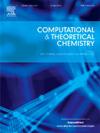A theoretical evaluation of the multiple radical scavenging reactions of Hibiscetin
IF 3
3区 化学
Q3 CHEMISTRY, PHYSICAL
引用次数: 0
Abstract
Density functional theory has been used to study the multiple free radical scavenging properties of the most hydroxylated flavonol, Hibiscetin in the gas, benzene, and water phases. The antioxidant activity of the hydroxyl group is decreased by intramolecular hydrogen bonds, which act as hydrogen bond donors, and increases by hydrogen bond acceptors. The continuous di‑hydrogen atom transfer (HAT) reaction from the catechol groups creates stable quinones in the gas and benzene phases. The penta-HAT mechanism is preferred in the Gas phase and benzene medium, both generating di-quinone 3′-radical. There was no possibility of further HAT, as shown by the high BDE values (>100 kcal/mol). The Frontier molecular orbital and molecular electrostatic potential analyses complement the findings. Hibiscetin prefers to undergo sequential proton loss reactions in the aqueous phase, yielding a hepta anion which then undergoes five successive electron transfer processes to generate the di-quinone di-anion-radical. The free energy calculation with specific reactive oxygen radicals validates the results. The discovery is further supported by the gas phase basicity (GPB) and pKa calculation. The initial pKa is 8.7 and GPB is 316.2, both of which are in agreement with findings from related compounds published in the literature.

对芙蓉黄素多种自由基清除反应的理论评估
本文章由计算机程序翻译,如有差异,请以英文原文为准。
求助全文
约1分钟内获得全文
求助全文
来源期刊

Computational and Theoretical Chemistry
CHEMISTRY, PHYSICAL-
CiteScore
4.20
自引率
10.70%
发文量
331
审稿时长
31 days
期刊介绍:
Computational and Theoretical Chemistry publishes high quality, original reports of significance in computational and theoretical chemistry including those that deal with problems of structure, properties, energetics, weak interactions, reaction mechanisms, catalysis, and reaction rates involving atoms, molecules, clusters, surfaces, and bulk matter.
 求助内容:
求助内容: 应助结果提醒方式:
应助结果提醒方式:


